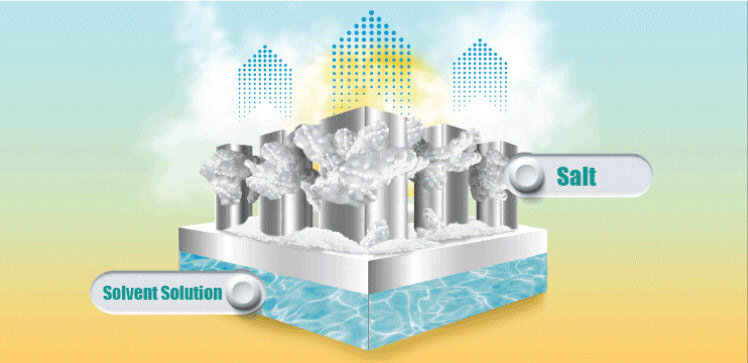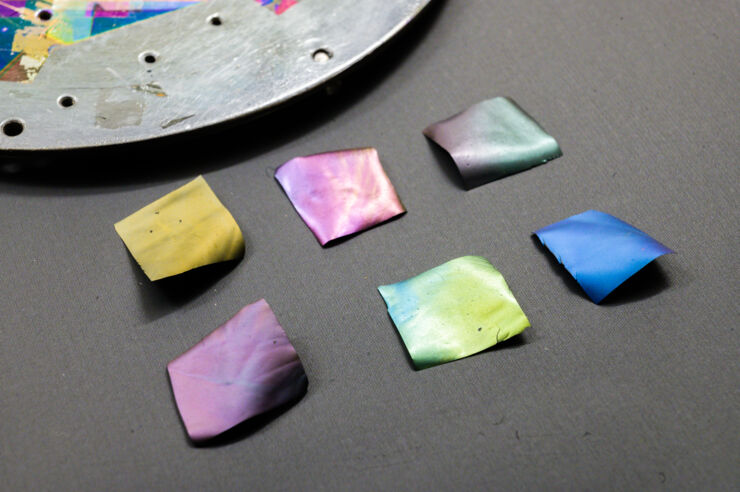
KAUST scientists have developed a simple cooling system based on solar energy and the cooling effect of saltwater evaporation that could be used for refrigeration in hot regions with limited access to electricity.
Credit: Veronica Moraru.
A simple cooling system driven by the capture of passive solar energy could provide low-cost food refrigeration and living space cooling for impoverished communities with no access to the electricity grid.
The system, which has no electrical components, exploits the powerful cooling effect that occurs when certain salts are dissolved in water. After each cooling cycle, the system uses solar energy to evaporate the water and regenerate the salt, ready for reuse.
“Hot regions have high levels of solar energy, so it would be very attractive to use that solar energy for cooling,” says Wenbin Wang, a postdoc in Peng Wang’s lab. In many parts of the world, there is a greater need for cooling because of climate change, but not every community can access electricity for air conditioning and refrigeration. “We conceptualized an off-grid solar-energy conversion and storage design for green and inexpensive cooling,” Professor Wang says.
The team designed a two-step cooling and regeneration system, with the cooling step based upon the fact that dissolving certain common salts in water absorbs energy, which rapidly cools the water. After comparing a range of salts, ammonium nitrate (NH4NO3) proved to be the standout performer, with a cooling power more than four times greater than its closest competitor, ammonium chloride (NH4Cl). The ammonium nitrate salt’s exceptional cooling power can be attributed to its high solubility. “NH4NO3’s solubility reached 208 grams per 100 grams of water, whereas the other salts were generally below 100 grams,” Wenbin says. “This salt’s other advantage is that it is very cheap and already widely used as fertilizer,” he adds.
The system has good potential for food storage applications, the team showed. When the salt was gradually dissolved in water in a metal cup placed inside a polystyrene foam box, the temperature of the cup fell from room temperature to around 3.6 degrees Celsius and remained below 15 degrees Celsius for over 15 hours.
Once the salt solution reached room temperature the team used solar energy to evaporate the water using a bespoke cup-shaped 3D solar regenerator. The cup was made from a material designed to absorb as much of the solar spectrum as possible. As the water evaporated, the NH4NO3 crystals grew over the cup’s outer wall. “The crystallized salt can be collected automatically as the salt drops off due to gravity,” Wenbin says.
Once collected, the salt effectively represents a stored form of solar energy, ready to be reused for cooling again when required.
Original Article: Strong sunlight powers passive cooling device
More from: King Abdullah University of Science and Technology
The Latest Updates from Bing News & Google News
Go deeper with Bing News on:
Passive cooling device
- Zoogeochemists measure how animals change the chemistry of their environmentson April 26, 2024 at 5:52 pm
Ecologists are blazing trails in a new field they’ve dubbed zoogeochemistry, which explores how animals influence nutrient cycling and carbon entering and exiting their ecosystems. Through everyday ...
- Vanadium Compounds in Emerging Electronics, Electrics, Cooling: Global Market Analysis and Technology Research Report 2024-2044on April 23, 2024 at 9:13 pm
Cooling: Markets, Technologies 2024-2044" report has been added to ResearchAndMarkets.com's offering. This commercially-oriented research report is designed to assist added value materials and device ...
- Cooling Off an Island Paradiseon April 21, 2024 at 4:00 am
Through the use of technology, an off-grid island resort was able to drastically cut its energy consumption as well as its reliance on diesel generators.
- MacBook Air M3 vs M2 vs M1 gaming performance comparisonon April 19, 2024 at 5:09 am
Learn more about what you can expect from the gaming performance when playing on Apple Silicon MacBook Air laptops natively. Frame rates are ...
- Someone made a gaming handheld out of the original 1994 PlayStationon April 17, 2024 at 3:45 am
The original PlayStation turns 30 this year – it was released in December 1994 in Japan. Now, someone managed to cram it in a gaming handheld not much bigger than a foldable like, say, the Galaxy Z ...
Go deeper with Google Headlines on:
Passive cooling device
[google_news title=”” keyword=”passive cooling device” num_posts=”5″ blurb_length=”0″ show_thumb=”left”]
Go deeper with Bing News on:
Passive cooling
- 2024 Tesla Model 3 Performance First Look: Big Power for the Smallest Tesla EVon April 25, 2024 at 11:23 am
With Pirelli P Zero tires on every corner, the Model 3 Performance should have tons of grip despite its hard acceleration, and its new 20-inch aluminum wheels are said to be lightweight. Larger brake ...
- Yes, there are benefits to suburban lawns. Here are a fewon April 25, 2024 at 2:12 am
I find this claim a little hard to believe. Lawns absorb carbon dioxide and produce oxygen, provide passive cooling, prevent soil erosion, absorb rainwater and prevent flooding. They’re also ...
- A primer on campus decarbonization in Washingtonon April 25, 2024 at 12:01 am
cooling, and electrical loads. Example strategies may include retro-commissioning, building envelope improvements, lighting retrofits, solar control and passive heating, occupant-scale comfort ...
- Press the hot button for cooling needson April 24, 2024 at 10:44 am
The escalating temperatures can pose a significant economic burden. Heat stress diminishes productivity due to higher mortality rates, health consequences, and decreased working hours. Addressing ...
- Harlem Passive House Property Launches Saleson April 23, 2024 at 5:00 pm
The Dovecote’s Passive House design offers continuous thick insulation ... The result is a reduction in need for energy to provide heating and cooling. In a prepared corporate statement, an Urban ...
Go deeper with Google Headlines on:
Passive cooling
[google_news title=”” keyword=”passive cooling” num_posts=”5″ blurb_length=”0″ show_thumb=”left”]










